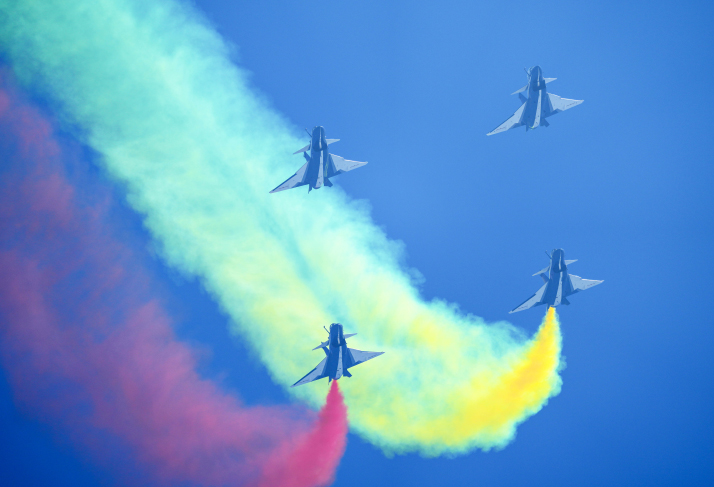
China’s new stealth fighter jet, the J-35A, made its public debut on November 12 at the 15th China International Aviation and Aerospace Exhibition (Airshow China).
A J-35A staged a brief performance following the opening ceremony of Airshow China, which began that same day in Zhuhai, Guangdong Province, and ran through November 17.
As China’s second stealth fighter, alongside the J-20, the J-35A emerged as the star of this year’s airshow. Once the J-35A is officially commissioned, China will become the second country in the world, after the United States, to have two different types of stealth fighter jets in active service.
Unlike the J-20, a heavy stealth fighter primarily designed for air superiority, the J-35A is a medium-sized, multi-role stealth fighter capable of both air superiority and precision strike missions against ground and maritime targets.
Chinese military aviation expert Fu Qianshao told newspaper Global Times that the J-35A is likely to be less expensive than the J-20, so it can be produced in large quantities within a short timeframe.
The J-35A was just one highlight among an impressive lineup of cutting-edge military hardware debuting at the airshow, offering a glimpse into the latest progress in the modernization of China’s military.
Since its inception in 1996, Airshow China has become an important window for showcasing advanced aviation and aerospace technologies and equipment from home and abroad.

A strategic edge
Alongside the J-35A, the People’s Liberation Army (PLA) Air Force unveiled some of its most advanced weaponry at the airshow, including the HQ-19 surface-to-air missile system and a new attack reconnaissance unmanned aerial vehicle.
The HQ-19 surface-to-air missile system is primarily designed for regional interception of ballistic missiles, demonstrating a big leap in China’s land-based air and missile defense capabilities.
Fu said the HQ-19 is comparable to the U.S.-made THAAD system, which can intercept ballistic missiles both outside and at the upper edge of the atmosphere. The U.S. complements THAAD with the Patriot air defense system for lower-altitude targets.
“The HQ-9B [long-range surface-to-air missile] and HQ-19 form a similar system, capable of intercepting missiles during the mid-course and terminal phases across outer space, the upper atmosphere and the lower atmosphere. The HQ-19’s official debut marks a new level of integrated air and space defense for the PLA Air Force, combining offensive and defensive capabilities,” Fu explained.

The PLA Navy made its debut at the airshow this year, showcasing a flight demonstration that featured the J-15D, a carrier-based electronic warfare aircraft, and the J-15T, a carrier-based fighter jet.
The two-seat J-15D combines advanced jamming capabilities with strike functions, potentially playing a critical role in securing air superiority for aircraft carrier battle groups. Its jamming systems offer vital protection by disrupting enemy communications, radar and guidance systems.
The J-15T, an upgraded version of the original J-15, is equipped with the latest radar and weapons systems and is compatible with catapult launch systems, Chinese military expert Zhang Xuefeng told Global Times.
The catapult launch capability enables the J-15T to take off with a heavier payload, including additional weapons and fuel.

Cutting costs in space
A model of the reusable cargo spaceplane, the Haoloong space shuttle, was also on display. The shuttle was designed by Chengdu Aircraft Design and Research Institute in Sichuan Province under state-owned defense conglomerate Aviation Industry Corp. of China (AVIC).
The Haoloong is intended to help reduce the costs associated with transporting cargo for the operation of China’s Tiangong space station.
Zhang Jichao, Deputy General Manager of AVIC, explained during a news conference in Zhuhai on November 11 that once operational, the Haoloong will be launched aboard China’s commercial carrier rockets to dock with Tiangong. After completing its mission, the shuttle will return to Earth’s atmosphere and make a horizontal landing on a runway, similar to a conventional aircraft.
“The model is designed for high reusability and can transport materials back and forth between the space station and Earth,” he added.
Currently, China has only one model of cargo spacecraft, the Tianzhou, developed by the China Academy of Space Technology in Beijing.
At the airshow, the China National Space Administration also showcased lunar samples collected during China’s Chang’e-6 mission from the far side of the moon.
The display included approximately 75 mg of lunar soil, which was collected from the largest, deepest and oldest impact crater on the far side of the moon, where the lunar crust is thinnest.
The exhibition also featured the Chang’e-6 return capsule, the parachute used when delivering the lunar samples to Earth, and the sealed container employed for the lunar soil collection.
In June, the Chang’e-6 mission brought back 1,935.3 grams of samples from the far side of the moon—the first such achievement in human history. –The Daily Mail-Beijing Review news exchange item





